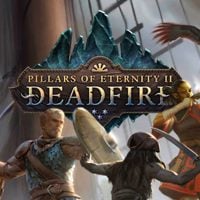Pillars Of Eternity 2: Best party
Which companions should I choose and what is party's AI? Learn everything about party in Pillars of Eternity 2.
In Pillars of Eternity 2 Deadfire, party is the basis of the gameplay. You don't start the game with a complete set of companions (you can command up to five characters, including your main character). However, you can find them rather fast - check out "How to easily recruit first companions?" chapter in the FAQ section.
Information related to managing your party can be divided into the following topics:
- Which classes should be in your party?
- Formations - how to place your party on a battlefield?
- Party AI
- What is the difference between companions and helpers?
Which classes should be in your party?
You will come across various companions during your playthrough. Due to the members limit in your party (up to five members), you will have to decide who stays and who needs to leave. The choice is in 100% yours but creating a versatile party is a good idea - thanks to that your characters will be able to deal with every situation. The example listed below is a perfect combination for the beginners.
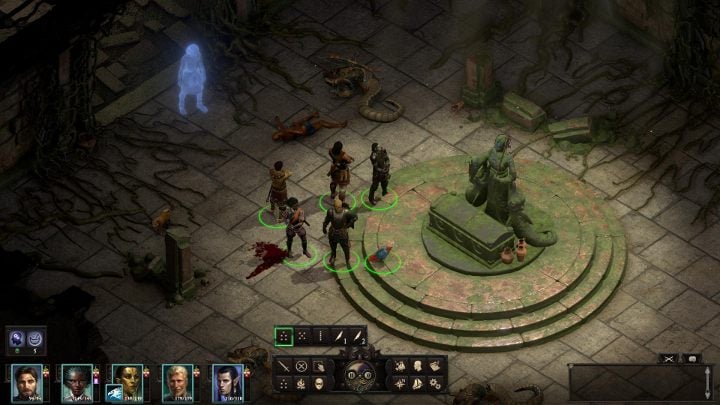
A character who focuses enemy attacks on themselves is a party's fundament. Fighter or Paladin are perfect for that role - develop one of these classes to have as much defense and health as possible. Here, you can get abilities like Knock Down or Charge which can interrupt enemy attacks and stop them from attacking other party members. Besides a so called "tank", you can also use another melee-oriented character. However, this person should focus on dealing damage. Barbarian, Fighter or Monk are your best choice - of course, you can't forget to unlock abilities that deal devastating damage.
The second line in your formation should consist of two ranged characters. Here, you can use a Wizard who can deal massive damage to both single and multiple targets - such as Fan of Flames or Fireball spells. The next useful character is a Ranger - they deal a lot of damage to single targets and they can use animal companions. Thanks to that your party can have six members (animal companions have their own abilities and can be controlled during battles).
The last role is support - this person can regenerate health of your party and inflict positive statuses such as better Accuracy or Deflection. The best classes for this role are a Priest and a Chanter but a Paladin or a Druid are useful, too. A support character can have a few supporting spells (healing or inflicting positive bonuses) but don't forget that they can also be a threat to your enemies - they can remove positive status effects or knock them down on ground.
Formations - how to place your party on a battlefield?
Your party moves in a certain formation that can be changed at any point of the game - simply click on the "Formation" icon located on the left side. This opens a window where you can see three preset formations: a square, an "X" formation and a line. Besides that, you can also find two other icons - here, you can create your own formations.

Click on them with right mouse button to open the creator presented above - set your party members in a desired formation by moving their portraits.
A formation should be adjusted to your party members. If you use the party described above then you should make sure that your melee characters are in the first row - they are the ones who have to withstand the biggest amount of damage (or at least you increase your chances to focus enemy attention on them - having a perfect formation for every enemy is impossible). The second row should consist of characters who deal ranged damage, and their animal companions. A support character should be in the very back. Of course, placement of your characters should be adjusted to a current situation on a battlefield - enemies can often surprise you and break your "perfect" formation.
Party AI
The key to win every fight is to control every single character in the right way and to use pause a lot. However, you can't have control over every situation or maybe a situation doesn't require putting so much effort into it (there is no point in using complicated tactics against weak enemies).
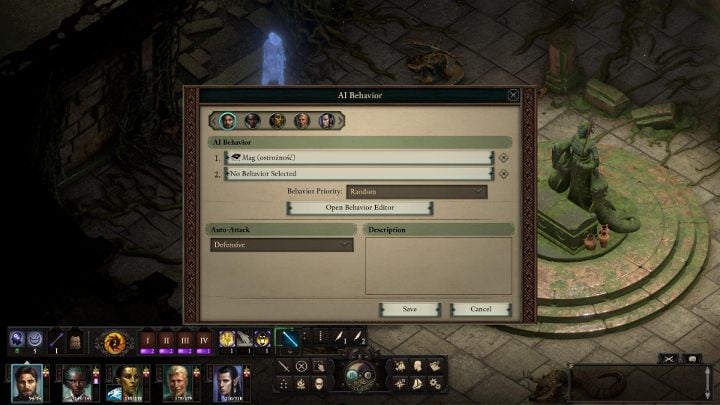
To have your team behave in the way you want them to, you can set them the right AI behaviors - this mechanic's menu can be opened by clicking on a character's portrait and then click with the right mouse button on the icon depicting a head with gears. You can now see the window from the picture above - the developers have prepared two presets for behaviors: "Cautious" and "Aggressive". You can probably already tell what these settings mean but their more detailed descriptions can be checked by clicking on "Open Behavior Editor" button - here, you can see how each character will behave in a given situation.
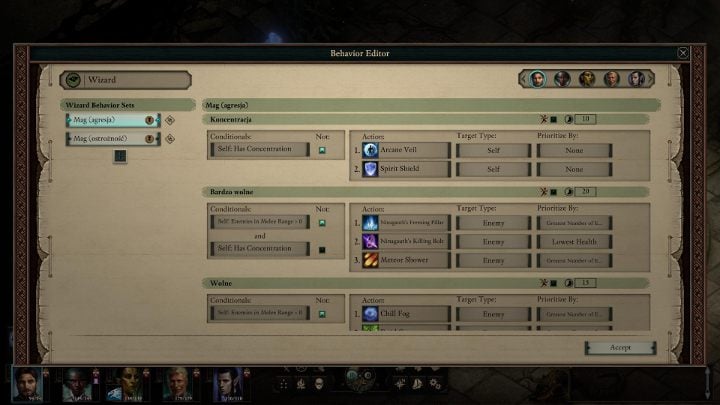
The menu above also allows you to create your own AI behaviors. Thanks to the complex creator you can adjust your companions' actions (use a certain spell or an ability) to multiple different conditions (e.g. when a character's health is below a certain number, a target is a beast or when a character can equip a shield). Number of combinations is limitless - you can adjust companions' AI to various situations that may happen on a battlefield.
AI behavior menu also has an option to adjust auto attack. Choose from four premade stances created by the developers:
- Passive - a character won't attack automatically, regardless of circumstances.
- Self-defense - a character won't engage in combat unless they get attacked by an enemy.
- Defensive - a character attacks nearby enemies automatically, regardless of whether they were attacked or not.
- Aggressive - a character attacks all enemies, regardless of whether they were attacked or not.
What is the difference between companions and helpers?
During the game you'll encounter various people wanting to join your party. You can divide them into two groups: companions and helpers.
You can choose from seven companions: Eder, Xoti, Aloth, Serafen, Pallegina, Maia and Tekehu. Their locations are listed on the next page (Locations of companions and relationships). Helpers are any remaining characters that can join the party (e.g. Konstanten from The Wild Mare (M19) in Neketaka or any other adventurer hired in any tavern).
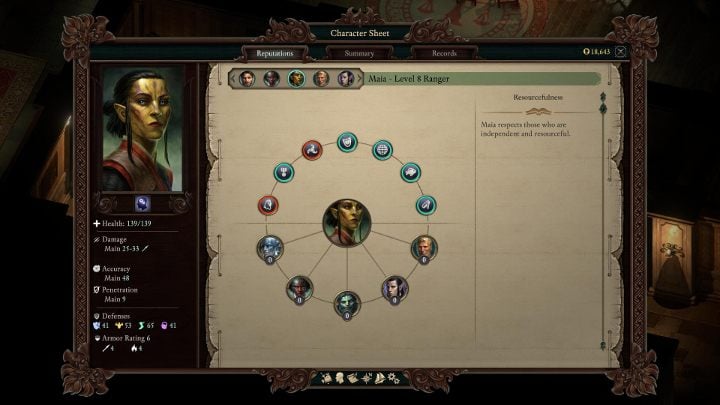
At first sight, there are no differences - companions and helpers can both take part in combat and have their unique plaques in the game's interface. Nevertheless, companions have unique characters with a set of traits and beliefs, you can engage in complex dialogues with them and receive new tasks or engage in relationships (romances, even). In short: companions are fully-fledged party members with whom you can engage in complex relationships.
You are not permitted to copy any image, text or info from this page. This site is not associated with and/or endorsed by the Versus Evil or Obsidian Entertainment. All logos and images are copyrighted by their respective owners.
Copyright © 2000 - 2025 Webedia Polska SA for gamepressure.com, unofficial game guides, walkthroughs, secrets, game tips, maps & strategies for top games.
